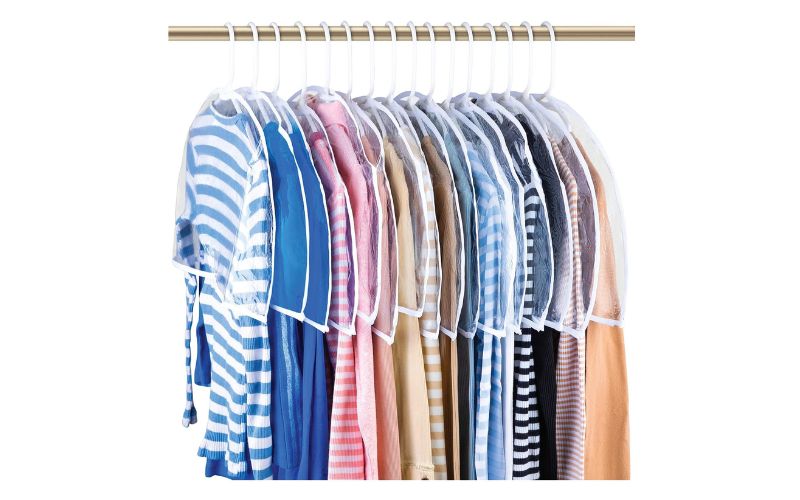When selecting commercial clothing racks for your business, it's important to consider different factors to guarantee you make the best decision. Consider your space, the types of garments you're showcasing, and the overall display layout you want to achieve. Each rack type, whether round, straight rod, or multi-tiered, offers unique advantages. Durability and mobility features should be noticed, too. How do customization options like adjustable heights and dividers play into your strategy? Let's explore how choosing the right racks can transform your store's organization and visual appeal.
Keep your clothes protected and dust-free with our Clear Vinyl Shoulder Covers - Get your set of 12 now!

Types of Clothing Racks
When selecting commercial clothing racks for your business, it's important to understand the different types available to best suit your display needs.
- Round racks offer a circular display, allowing customers to view items from all angles, making them ideal for central store positions.
- On the other hand, straight rod clothing racks provide a simple and sleek design, perfect for lining walls or creating organized rows of garments. If maximizing space efficiency is a priority, 2-way and 4-way clothing racks are excellent options. These racks allow for multiple display angles, showcasing more items without taking up additional floor space.
- For businesses looking to save floor space, wall-mounted racks are a fantastic solution. These racks attach directly to walls, freeing up valuable square footage while providing ample display area.
Choosing the right type of clothing rack depends on your space availability, display preferences, and the garments you plan to showcase. Understanding these options helps ensure your retail space is functional and visually appealing.
Key Features to Consider
Choosing the right type of clothing rack is just the beginning; now, let's focus on the key features that will guarantee you the most of your investment.
To maximize efficiency and functionality, consider the following:
- Load Capacity: Guarantee the rack can handle the weight of your merchandise. Standard racks hold about 120 pounds, but you might need more if you display heavier items.
- Durable Materials: Opt for heavy-duty steel or other robust materials to ensure that your rack withstands daily wear and tear and provides long-lasting use.
- Mobility Features: Look for racks with wheels or collapsible designs. These features make moving and storing the racks easy, especially useful in dynamic retail environments.
- Customization Options: Adjustable heights, dividers, hat racks, and double-rail garment racks can offer versatility. These features allow you to tailor the rack to your specific display needs, ensuring you can effectively showcase various items.
Additionally, pay attention to the value of dustproof covers. They protect your merchandise from dirt and damage, keeping everything in pristine condition.
Tips To Pick The Right Commercial Clothing Racks
Set up a retail store, boutique, or showroom—commercial clothing racks are the best choice for creating a seamless shopping experience for customers while maximizing space and product showcase. Below, we explain the most critical factors in adding features like shelves, jewelry displays, and metal racks to suit your business requirements.
1. Know Your Space and Layout
Evaluate your retail store layout before purchasing clothing racks. Measure your floor area, specifically those allocated to shelves, tables, and bins. For busy areas, choose racks that do not impede flow or bottlenecking. Vertical shelving and rack panels are advisable for better space usage potential. If the space is limited for racks, wall-mounted racks save valuable floor space, providing just enough room for merchandise.
Pro Tip: Employ multi-tiered racks, Z racks, or mobile carts to add variety to the displays without overloading the store. Install handrails or Slatwall configurations to group items such as coats, bags, and clothing.
2. Determine Your Store's Aesthetic
The racks need to be compatible with your store's design theme. Use chrome racks and grid wall panels, or combine them with black shelving for a more modern look. Wooden shelves in warm finishes create a charming ambiance for a rustic or vintage theme. Even in boutiques and high-end showrooms, the design has to create a sense of brand perception. Display jewelry, bracelets, or watches elegantly with countertop holders or mannequins to enhance the aesthetic appeal.
3. Durability and Material
Retailers with heavy inventories need to make sure they use tough materials. Some of the materials that are used include:
Steel: This is ideal for industrial applications because it is strong and can hold huge amounts of material, such as clothing, bags, or shoes.
Wood: It is useful for boutiques or small showrooms to add a classy feel, yet sturdy enough for small loads.
Plastic or Acrylic: It is lightweight and inexpensive but most useful for accessories or limited seasonal collections.
For heavy items, such as coat racks or slatwall shelving for displays, ensure that the racks have strong support tubing and can carry heavy weights.
4. Flexibility and Customization
Adjustable racks make it possible to readily reconfigure your displays when inventory changes seasonally or with promotions by salesmen. Consider the following features:
- Height-adjustable handrails
- Adjustable length of racks for increased apparel stock
- Rolling carts or racks with lockable wheels are used for convenient relocation to another room, for example, during flash sales or seasonal reconfiguration.
- Z racks and grid wall shelves are versatile, accommodating everything from cloth racks to jewelry holders.
5. Specialized Rack Types
Different rack styles cater to specific retail store needs. Here's the breakdown:
Round racks: Ideal for sales that feature bulk quantities like T-shirts or discounted apparel.
Waterfall racks: Perfect for showcasing seasonal clothing collections or zeroing in on specific outfits.
Wall-mounted racks: Ideal for closet-style displays, Slatwall setups, or premium accessories like watches and bracelets.
Multi-level racks: Space-saving and great for smaller boutiques.
Select racks tailored to your inventory type, whether apparel, bags, or jewelry.
6. Budget Wisely
While quality commercial racks are pricey, they're an investment in the life of your displays. Compare your pricing and look for options with top shipping and support services. For lighter items, plastic racks can make the price even cheaper. Metal or steel racks might be worth the bigger price tag because they are more durable and carry more loads.
Pro Tip: Saving money in the long run from fewer replacements due to high-quality racks.
Benefits Of Choosing The Right Commercial Clothing Racks
Selecting the right commercial clothing racks for your business offers several key benefits:
Improved Organization: Gridwall and pegboard systems help you organize your products in an efficient and aesthetically pleasing manner. Because of this, your customers can locate the things they need, thus contributing to sales.
Improved Customer Experience: Racks that are tastefully designed with casters and labels improve your store's aesthetic. A customer will enjoy shopping with you even more if you have all your products well-organized and easily accessible.
Maximized Display Space: Racks with adjustable arms or brackets can easily optimize your store’s display space. For example, a four-way rack allows you to display more garments in a small area, increasing your store's overall product visibility.
Durability and longevity: Your racks will last for ages with high-quality metal or wood. Hence, there is less need for frequent replacing, and your racks will function well for years to come.
Flexibility: Portable racks, wheeled racks, and modular display systems can easily adapt to the store's layout whenever needed. This is helpful during sales or special events, as you can easily change your displays to match the occasion.
Rack Alignment Strategies
Strategically aligning your clothing racks can dramatically improve customer flow and enhance their shopping experience. Well-aligned racks provide storage and a smooth traffic flow, allowing customers to navigate your store easily. By thoughtfully placing rod clothing racks and garment displays, you help organize the space and create visually appealing focal points.
Avoid overcrowding your racks to give customers ample room to move and explore. Properly spaced racks highlight key products more effectively, ensuring they catch the shopper's eye. Consider placing popular items at eye level and in high-traffic areas to draw attention.
Routine Maintenance Tips
Here are some essential tips for maintaining your clothing racks:
- Conduct Regular Inspections: Check your clothing racks for any signs of damage or wear. Look for issues like bent frames, loose screws, or rust that could compromise safety and functionality.
- Keep Them Clean: Dust and debris can accumulate over time, giving your store an unkempt look. Regularly clean the racks to maintain a polished and professional appearance. Use appropriate cleaning solutions to avoid damaging the materials.
- Check for Alignment and Stability: Ensure all racks are properly aligned and stable to prevent accidents or collapse. An unstable rack can be a hazard to both your staff and customers.
- Replace Broken Hangers and Fixtures: Broken or damaged fixtures can ruin clothing items and disrupt the organization. Promptly replace any broken pieces to maintain an orderly display.
Conclusion
Selecting the appropriate clothing racks for your business can make a significant difference. Consider your space, garment types, and display layout. Choose round racks for a 360-degree view or straight rod racks for wall displays. Utilize 2-way and 4-way racks to maximize space, or opt for wall-mounted options to save floor space. Prioritize durability, mobility, and customization features. Equipping the right racks will establish a well-organized, visually appealing store that effectively showcases your products.
Frequently Asked Questions
What is the best material for commercial clothing racks?
Steel is ideal for its durability and heavy load capacity, while wood provides a premium, boutique-style appearance.
How do I select a size of clothes rack for my store?
Measure your space and consider grid panels or shelving systems that fit your layout without overcrowding.
Are rolling racks a good option for retail stores?
Yes, rolling racks offer flexibility for retailers, who can easily move them around during sales or seasonal showcases. Other flexible choices include Z racks and grid wall shelves.
What is the difference between a grid wall and a pegboard display system?
A grid wall system comprises panels with a grid pattern where hooks, shelves, and racks can be easily attached. It's great for flexible, customizable displays. On the other hand, a pegboard system is similar but has evenly spaced holes for inserting pegs to hold products. Both are versatile, but the grid wall offers more options for brackets and shelves, while the pegboard is more straightforward.
How do I take care of the quality of my clothing racks?
Inspect your racks periodically for any sign of wear or rusting, especially on points where hardware joins. Use gentle cleaners to wipe off surfaces and replace casters or arms when they break or malfunction. Most importantly, ensure proper rack installation with strong mounting points so that accidental damages do not happen.


